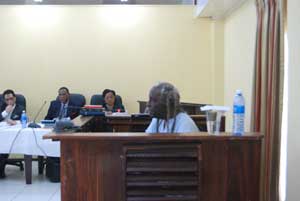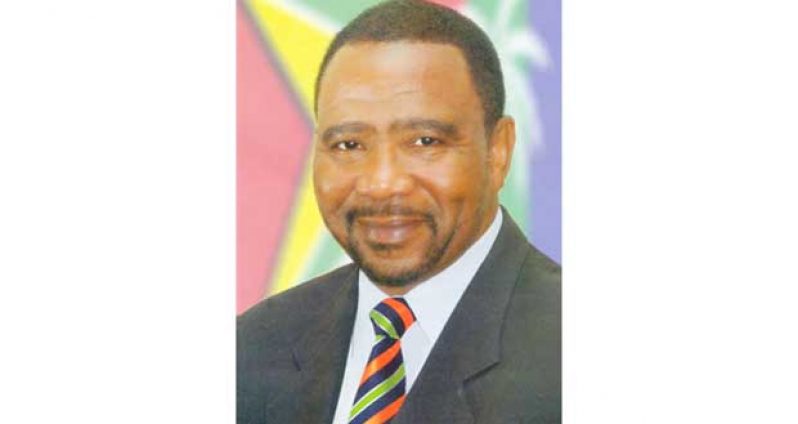–Disclosure stuns Rodney COI
GASPS of shocked disbelief yesterday echoed through the stunned silence of the courtroom where the Commission of Inquiry into Dr. Walter Rodney’s political assassination unfolds.
“The House of Israel received nine guns from Robert Corbin,” former senior leader of the House of Israel, Joseph Hamilton, told the stunned courtroom. Hamilton was testifying before the Commission about his role as a

leader of the House of Israel religious sect. He was referring to the sect’s politically “oppressive and terrorizing acts on behalf of the PNC.”
Referring to the then ruling People’s National Congress government, Hamilton spoke with clear, crisp sentences of his shadowy role to unquestioningly follow orders to “break-up political meetings” and engage in “oppressive and terrorizing” acts against members of the Working People’s Alliance (WPA).
The shocking, intriguing details emerged at the Inquiry linking the now-defunct House of Israel religious sect with key members of the ruling Government of the People’s National Congress.
Hamilton named Corbin and Hamilton Green among four key links between the religious sect and the PNC.
In the audience sat Dr. Rupert Roopnarine and Mr. Eusi Kwayana, both of whom served as confidantes and top leaders of the WPA alongside Rodney.
The full courtroom, silent and stony-faced as Hamilton recounted his intense and intimate role in the leadership of the House of Israel religious sect, reacted with a collective gasp when they heard of Corbin’s role to hand over the nine guns to the religious political oppressors.

Hamilton said he witnessed the events of the moments surrounding the stabbing death of Father Darke, a British citizen who wrote for the Catholic Standard newspaper, and was covering a street protest on Brickdam in Georgetown at the time.
Fearing that Father Darke had captured the violent political acts of 12 to 15 members of the House of Israel sect on his camera, at the protest, members of the religious sect, with their leader Rabbi Washington among them, grabbed the camera of a stabbed and badly wounded Father Darke, and handed it to Hamilton.
Hamilton said he grabbed the camera, clutching it for safe-keeping, and escaped from the street mob “of thousands of people.” He took the camera, which the sect believed contained damaging evidence of their political violence to the religious headquarters in Alberttown, Georgetown.
At today’s Inquiry sitting, Hamilton is scheduled to elaborate on what pictures were stored on the camera.
Hamilton’s explosive testimony, on the ninth day of the Inquiry, yesterday, built the tension of this historical drama to fever pitch.
The key question at stake is: Who assassinated Dr. Walter Rodney on June 13, 1980?
Rodney died instantly when a bomb disguised as a communication device exploded in his lap as he sat in his car.
Rodney’s death ricocheted across the world, and is the major political assassination in the history of the Anglo-Caribbean Region. He was an outstanding international scholar, a crusader for political justice, and a globally respected advocate for democracy in the Third World.
After becoming leader of the WPA, Rodney became the focus of heavy political harassment and oppressive “terrorizing” at the hands of members of the House of Israel religious sect, Hamilton testified under oath.
The shadowy mystery of this political assassination, along with suspicious rumours and persistent public perception that the Government of the People’s National Congress (PNC) was somehow implicated, has hung over the Guyanese nation and the international community for over three decades.
With the Inquiry finally underway, after nearly four decades, international interest is growing as the Commission seeks to identify who assassinated the great Guyanese scholar, and why he was killed. The Commission is also exploring the atmosphere in the country which would have caused such a deadly outcome to Rodney’s quest for an end of the dictatorship government of the time.
Earlier in the morning, WPA co-leader Kwayana fended off questions from Counsel Selwyn Peters, who tried to establish that Rodney was a man who took dangerous risks. Kwayana insisted that Rodney took no big risk, but instead put his life at risk in engaging in political opposition against the “dictatorship” Government of Forbes Burnham.
The audience, in tense silence as Hamilton stood in the witness box facing the Commission, saw the day’s testimonies end on a dramatic high, when Commission Chairman Sir Richard Cheltenham adjourned the Inquiry, to be resumed this morning, on the verge of Hamilton revealing what pictures were on Father Darke’s camera.
The audience, listening to Hamilton’s steady, firm tone of voice, is keenly anticipating Hamilton’s revelation of what pictures showed up on the camera that the religious sect had grabbed and hidden at its Alberttown headquarters.
Hamilton painted a shadowy, mysterious and highly organised political intrigue in the country lasting from the 1970s to the late 1980s, involving a paranoid political party that Kwayana labelled a “dictatorship,” and its sinister alliance with a secretive religious cult that snared “1,500 – 2000” sect followers “across the country, in villages.”
(By Shaun Samaroo)



.jpg)








